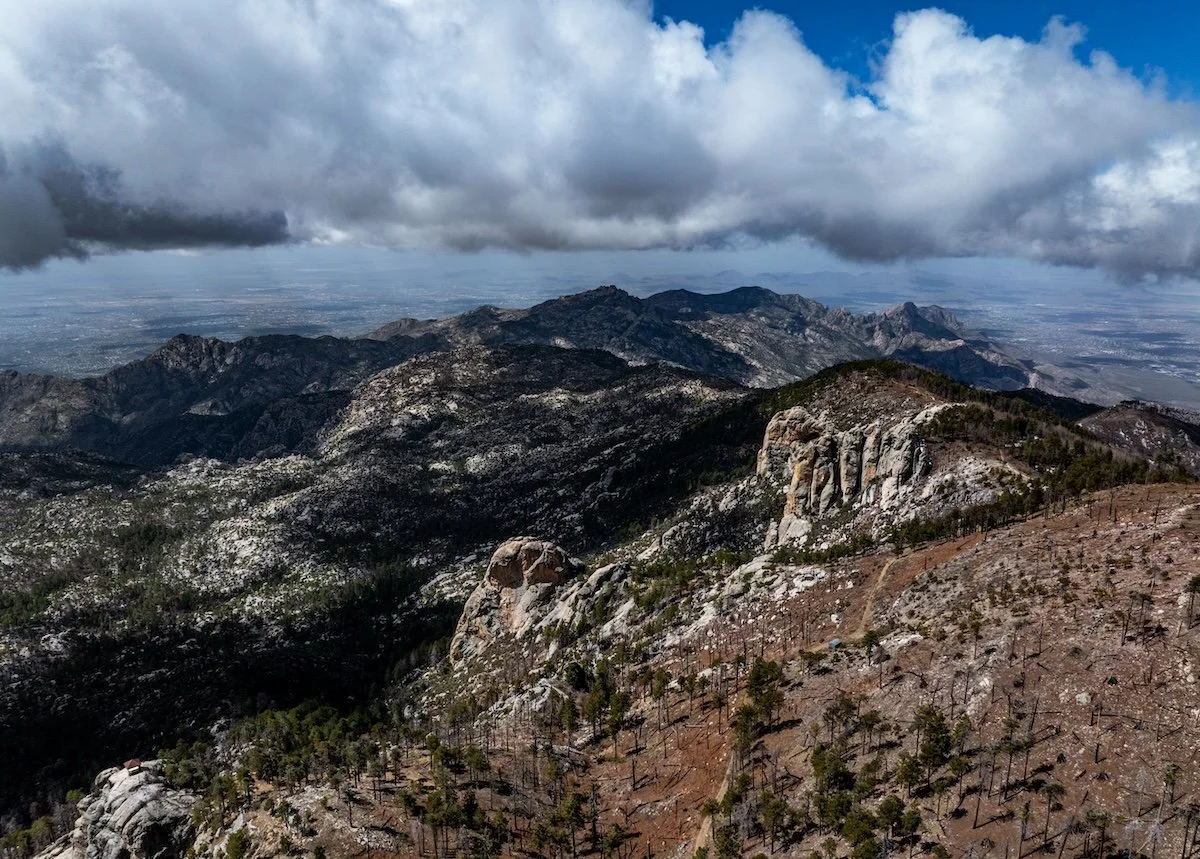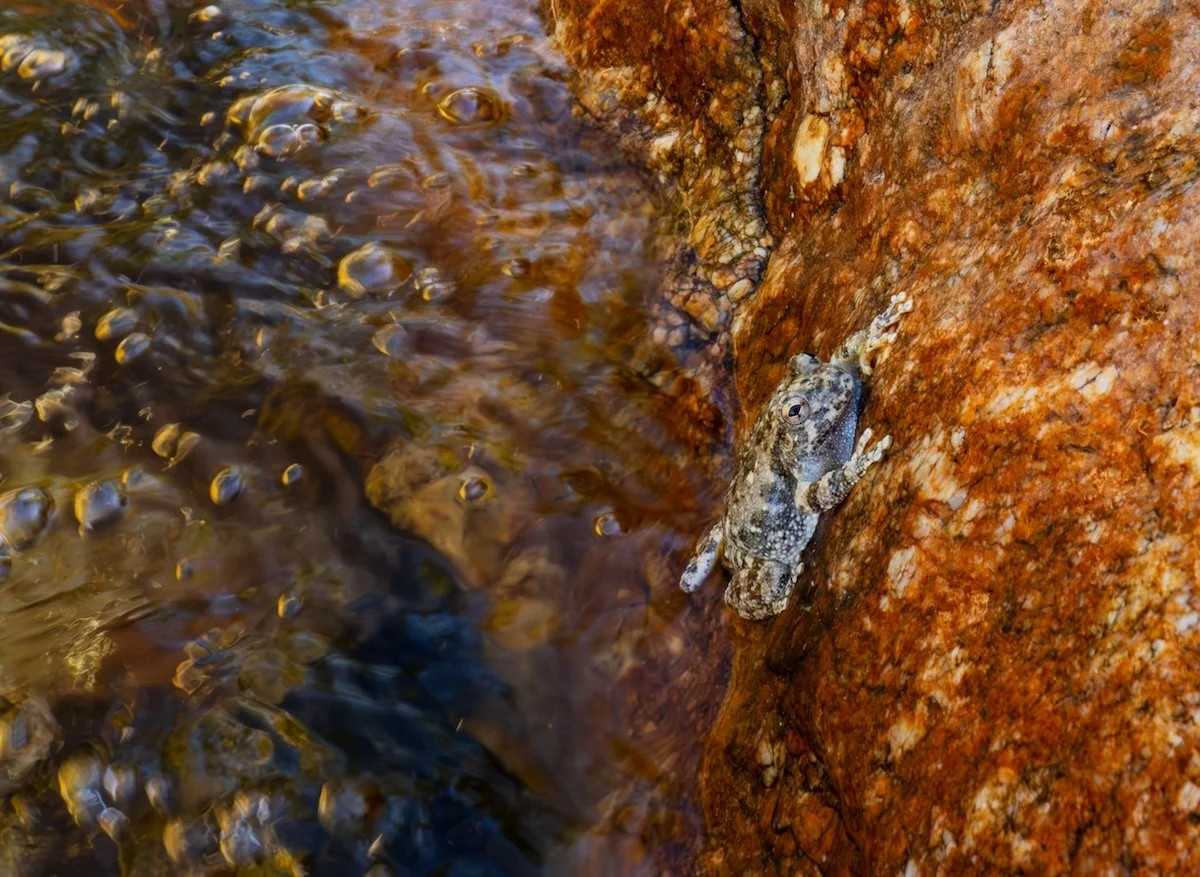Section two of my Sky Island traverse and biodiversity project is happening in the beautiful and varied Santa Catalina Mountains. And with Section two in full swing, I figured it was the perfect time to share a bit about this range and what makes it special.
The full length of the Tortilita range’s south slopes from my position looking north.
The Catalina mountains are super varied; containing 8 major biomes, from low Sonoran desert to subalpine forest. Needless to say, that is exciting to me. And I am looking forward to exploring some of the areas that will feel familiar. The ponderosa forests and majestic subalpine regions, specifically. It feel surreal that such variety exists in such a relatively small swath of planet.
The low point of this range sits right around 2,500ft, with a high point hitting 9,159ft at the summit of Mount Lemmon.
The Santa Catalinas have a few great water sources and during the time I’ll be traversing them, water shouldn’t be too big of an issue to manage. Creeks will be flowing as the snow up high melts.
The geology of the Santa Catalina Mountains is influenced by the broader tectonic processes occurring in the southwestern United States, particularly within the Basin and Range Province. The Catalinas are characterized by block faulting and crustal stretching. The range itself is formed by a series of fault blocks that have been uplifted due to tectonic forces. These mountains are bounded by numerous faults, including the Catalina Detachment Fault, which separates the Catalina core complex from the surrounding rocks. Uplift along these faults has exposed older rocks and created the rugged peaks and deep canyons of the range.
The mountains are primarily composed of a variety of igneous, metamorphic, and sedimentary rocks.
Igneous Rocks: Granites and granodiorites are common in the Santa Catalinas, formed from the cooling and solidification of magma deep within the Earth's crust.
Metamorphic Rocks: Schists, gneisses, and amphibolites are present, indicating the effects of intense heat and pressure on pre-existing rocks. These metamorphic rocks may have originated as sedimentary or igneous rocks that were altered by geological processes.
Sedimentary Rocks: Sedimentary formations such as limestone, sandstone, and shale are found in the Santa Catalina Mountains. These rocks were deposited in ancient seas, lakes, or rivers and later uplifted and exposed through tectonic activity.
The geological history of the Santa Catalina Mountains spans hundreds of millions of years. They began forming during the Precambrian era as igneous and metamorphic rocks were intruded and uplifted. Subsequent tectonic activity during the Paleozoic and Mesozoic eras deposited sedimentary rocks and further shaped the landscape. The region experienced significant uplift and faulting during the Cenozoic era, leading to the dramatic relief seen today.
The Santa Catalina Mountains serve as a major hotspot for biodiversity within the Sonoran Desert and Madrean Sky Islands. The big range of biomes and elevations are one of the main factors for that. There are many habitats for unique species to call home, and based on the elevation you find yourself in, you’ll experience fully different species.
It’s a wild thing to experience on foot. As I’m writing this, I have gone from low desert to ponderosa forest at just about 6,000ft and it’s been such a trip to go from seeing antelope squirrel to Aberts’ squirrel!
I could write forever about the biodiversity of flora and fauna in this range, but I don’t want to become too repetitive here. As I traverse the range, I will try to stay on top of posting images of what I’m experiencing instead of writing a list here. But bear with me; it’s not always easy to post from the field. Check back often for updates.
This is the first Sky Island I’m traversing where I might see Coati and I’m crossing all my fingers and toes that I catch a glimpse of these beautiful animals.
A canyon tree frog hangs out stream-side in the low country.
Conservation efforts in the Tortolita Mountains:
Fire Management: The Santa Catalina Mountains are prone to wildfires, which can have devastating effects on the ecosystem. Conservation efforts include controlled burns to reduce fuel loads, creating fire breaks, and implementing strategies for wildfire suppression and mitigation to protect both human communities and natural habitats.
In 2020 the Bighorn Fire created a lot of damage in this range, but it was one of many. Wildfire management is so important to the health of the Catalinas.
Habitat Restoration: Various organizations, such as Friends of the Santa Catalina Trails, work on habitat restoration projects in the Santa Catalina Mountains, focusing on reforestation, erosion control, and invasive species management. These efforts aim to restore the natural balance of the ecosystem and enhance habitat quality for native species.
Wildlife Conservation: Conservationists monitor and protect the diverse wildlife species found in the Santa Catalina Mountains, including endangered and threatened species such as the Mexican spotted owl and desert bighorn sheep. Efforts may include habitat preservation, population monitoring, and wildlife corridors to facilitate movement between fragmented habitats. Learn about the Coalition for Sonoran Desert Protection here!
Watershed Protection: The Catalina Mountains are a crucial source of water for Tucson and the surrounding region. Conservation efforts include watershed restoration projects, riparian habitat protection, and measures to maintain water quality in streams and rivers originating from the mountains.
Recreation Management: Balancing recreational use with conservation is essential in the Santa Catalina Mountains. Initiatives focus on sustainable recreation practices, trail maintenance, visitor education, and minimizing the environmental impact of recreational activities such as hiking, camping, and off-road driving.
Collaborative Partnerships: Various stakeholders, including government agencies, non-profit organizations, local communities, and Indigenous groups, collaborate on conservation initiatives in the Santa Catalina Mountains. These partnerships leverage diverse expertise and resources to address complex conservation challenges effectively.
Public Outreach and Education: Conservation organizations conduct outreach programs, educational events, and workshops to raise awareness about the importance of preserving the Santa Catalina Mountains' natural beauty and ecological integrity. Engaging the public in conservation efforts fosters a sense of stewardship and encourages sustainable behavior.
Mountain Lemmon SkyCenter Observatory
At the top of Mount Lemmon, there is an observatory operated by the University of Arizona that offers a unique opportunity for visitors to explore the cosmos through its state-of-the-art telescopes and educational programs.
The observatory houses several telescopes, including the 32-inch Schulman telescope, which is the largest dedicated public viewing telescope in the Southwest United States. There are also smaller telescopes available for public and educational use.
The SkyCenter offers a variety of public programs, including nightly observing programs where visitors can view celestial objects through the telescopes and learn about astronomy from knowledgeable guides. There are also special events, workshops, and educational programs for schools and groups.
In addition to its public outreach activities, the observatory is involved in various research projects, including studies of asteroids, comets, exoplanets, and other astronomical phenomena. The dark skies and advanced instrumentation make it a valuable resource for astronomers.
Some petroglyphs in the Tortolita Mountains.
As always, I will be mindfully implementing Leave No Trace practices in the Tortolita range. It’s truly a special Sky Island and by doing my part to sustain its wild beauty, I should have good luck with wildlife and be able to get to know these mountains in a much deeper sense.
If you’ve got any questions about Section Two of my Sky Island Traverse, drop em in the comment section!





